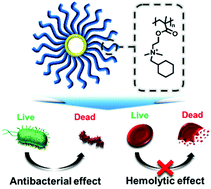Antibacterial and cytotoxic properties of star-shaped quaternary ammonium-functionalized polymers with different pendant groups†
Abstract
The correlation between the structure and biological activity of polymers is critically important for rationally designing effective antibacterial polymers. Here, the antibacterial activity, cytotoxicity, and selectivity of structurally well-defined, star-shaped quaternary ammonium polymers (S-QARs) containing various pendant groups with different carbon numbers (C1–C12) and atom connectivities (aliphatic/aromatic and cyclic/acyclic) were assessed and compared with their linear counterparts (L-QARs). While displaying comparable hemolysis and cell toxicity, S-QAR exhibited slightly stronger and faster antibacterial activity than L-QAR owing to its higher cationic charge/functional group density and greater hydrophobicity, afforded by its constrained and compact chain structure, thereby achieving superior selectivity. Furthermore, the aliphatic acyclic pendant group exhibited the highest antibacterial activity and relatively low mammalian cell toxicity, yielding the highest selectivity, owing to its balanced hydrophilicity/hydrophobicity and proper chain conformation/rigidity. Overall, the star-shaped architecture containing the aliphatic cyclic pendant structure for cationic amphiphilic polymers is highly desirable for effectively preventing bacterial infections.



 Please wait while we load your content...
Please wait while we load your content...